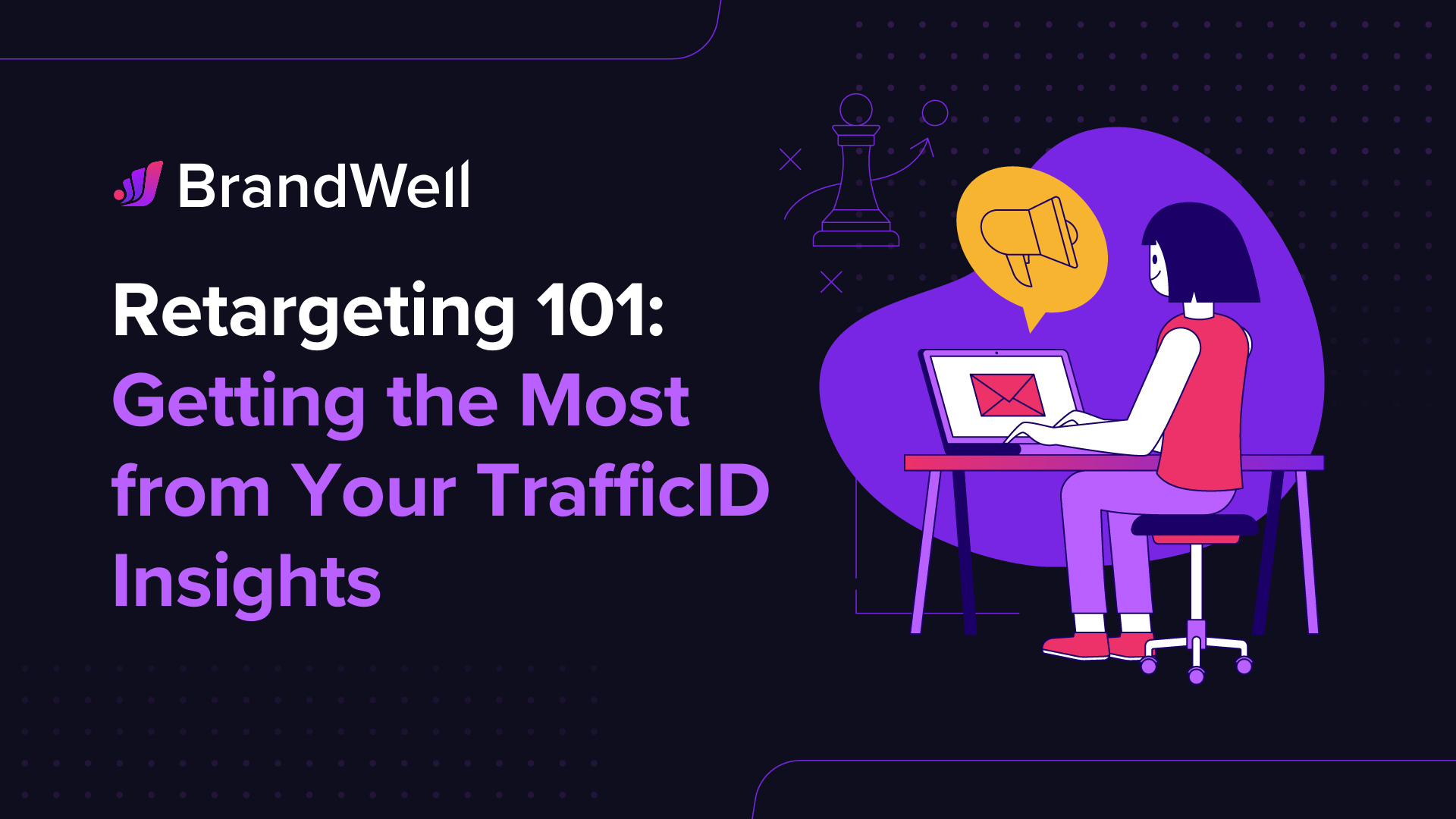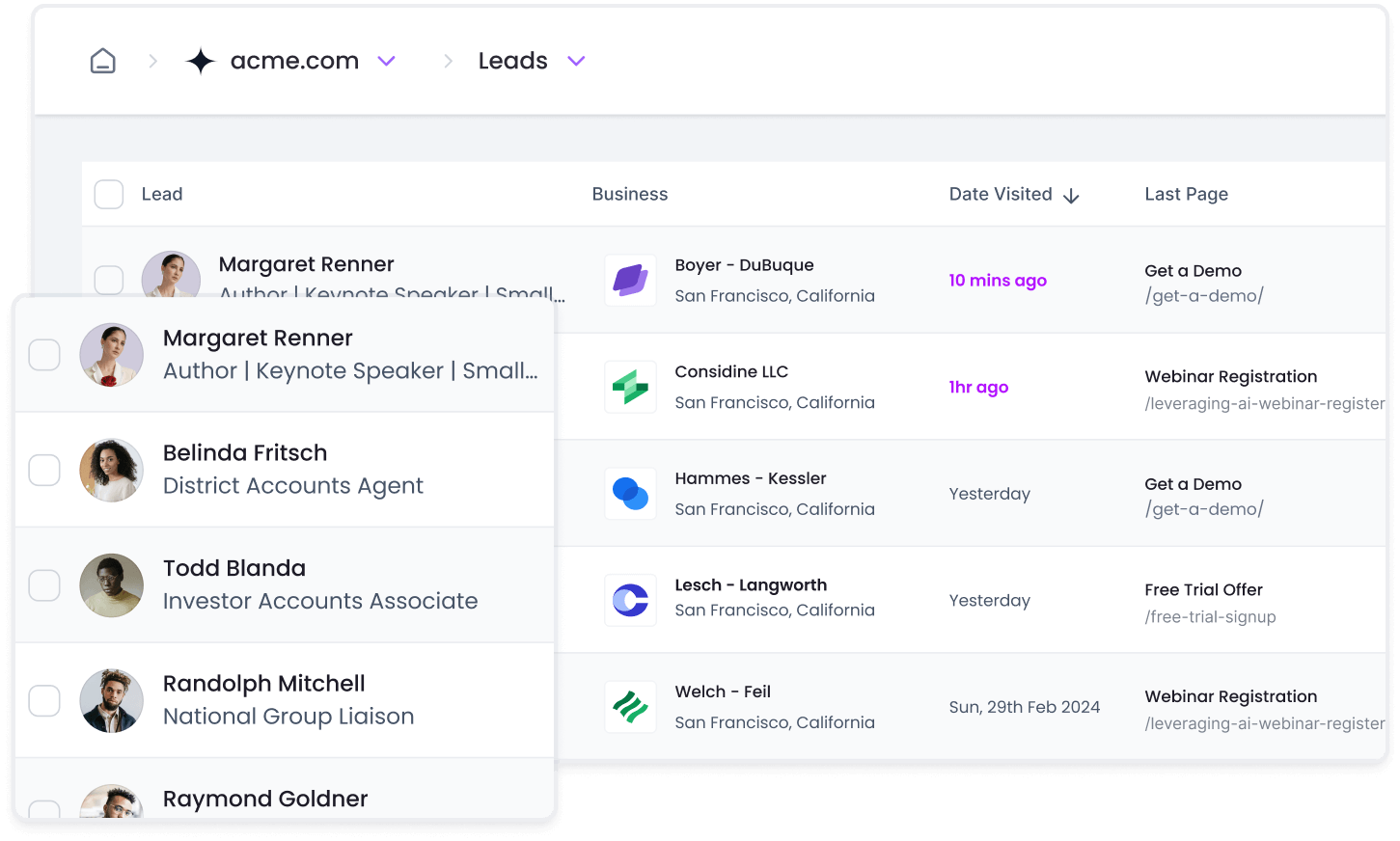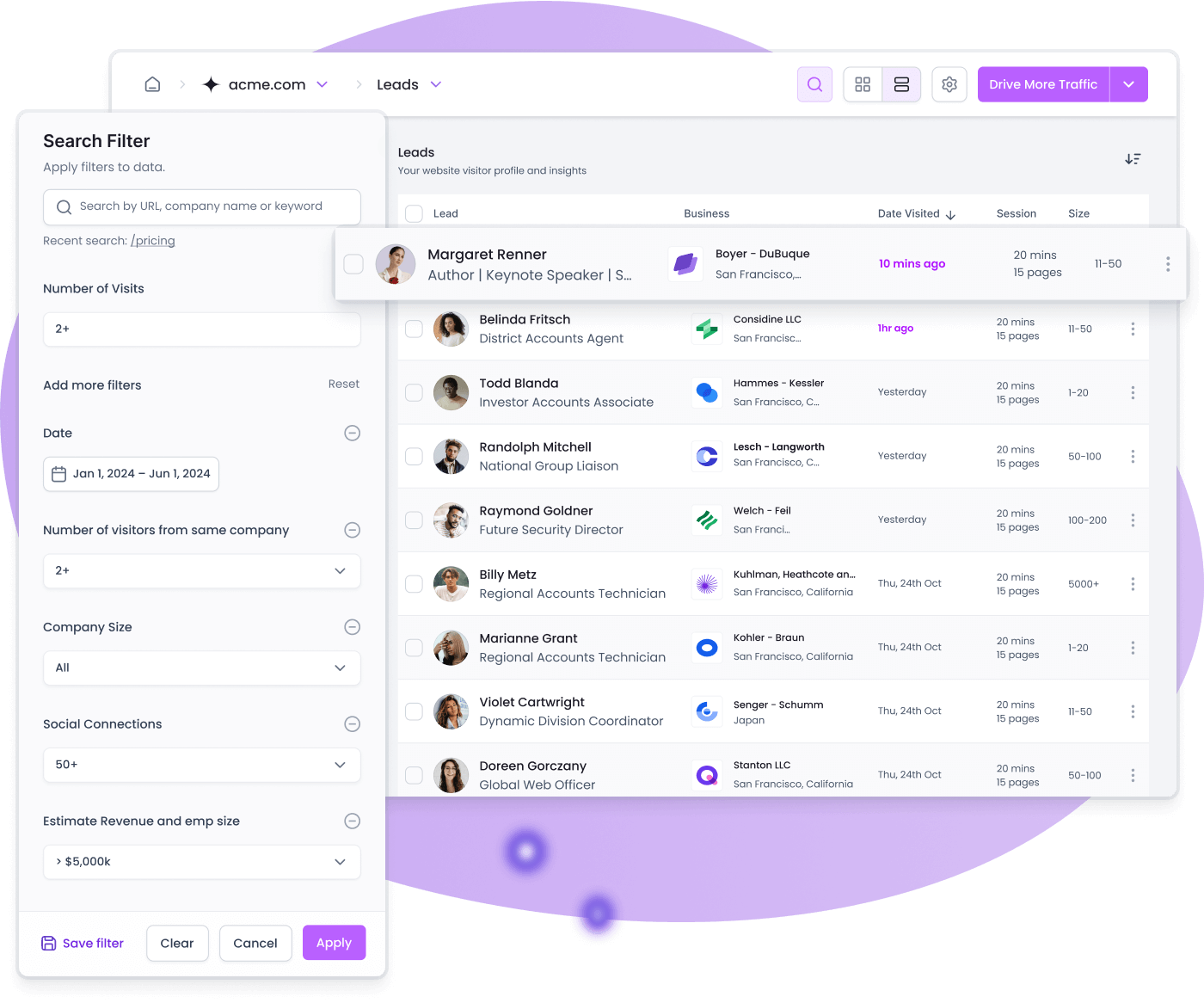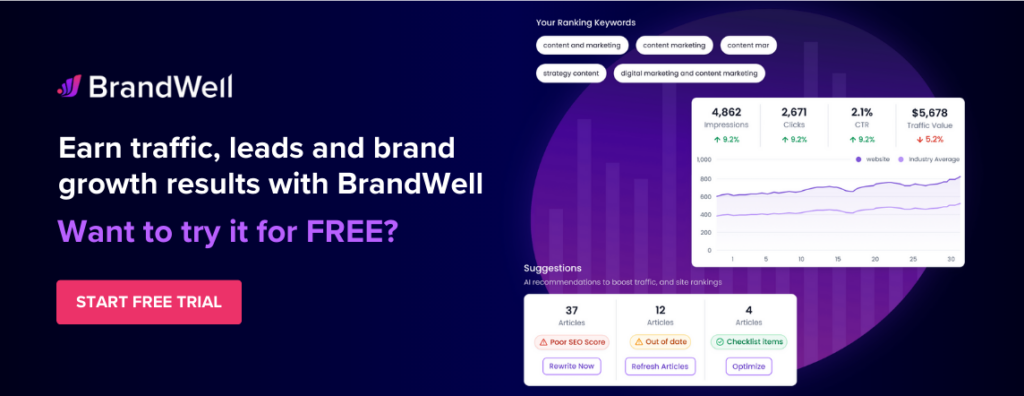Discover top guides, trends, tips and expertise from AIO Writers
Retargeting 101: Getting the Most from Your TrafficID Insights
Ben Harper
Monday, 9th Dec 2024
If you’ve ever browsed a website, only to see ads for that same site popping up all over the internet, you’re already familiar with retargeting. It’s one of the most powerful strategies in digital marketing, helping brands stay top-of-mind and bring back visitors who may have wandered off without converting.
But here’s the kicker: Did you know that 96% of visitors to your website aren’t ready to buy on their first visit? That means most of the people who land on your site will leave without taking any action, leaving your marketing team with the challenge of turning those casual browsers into loyal customers.
That’s where retargeting comes in. By showing ads to these visitors as they browse other sites, you have the chance to remind them of what they left behind and encourage them to return and take action.
In this guide, we’ll break down everything you need to know about retargeting — what it is, how it works, and how to use tools like Traffic ID to supercharge your retargeting campaigns.
Whether you’re in B2B sales or run a marketing agency, you’ll learn strategies that can help you turn those lost visitors into valuable leads.
Let’s dive in!
Table Of Contents:
- What is Retargeting?
- Remarketing vs. Retargeting: What’s the Difference?
- How Does Retargeting Work?
- Google Ads Retargeting
- Facebook Retargeting
- B2B vs. B2C Retargeting
- B2B Remarketing Best Practices and Strategies
- Don’t be Creepy: The Art of Non-Creepy Retargeting
- Why Traffic ID is the Ultimate Tool for B2B Retargeting
What is Retargeting?
Retargeting is the art of reaching out to website visitors who didn’t convert the first time they interacted with your site.
Instead of letting these potential customers simply bounce, retargeting allows you to remind them of what they were interested in, keeping your product or service top-of-mind until they’re ready to take action.
This is where tools like Traffic ID come in handy. By identifying the specific visitors who came to your site, you can create targeted ads that speak directly to their needs. Whether they were browsing your product pages, reading your blog, or checking out your pricing, retargeting helps you bring them back to complete the purchase or conversion.
Remarketing vs. Retargeting: What’s the Difference?
At first glance, “remarketing” and “retargeting” might seem like interchangeable terms, and in many ways, they are. However, they refer to two distinct strategies that, when used together, can supercharge your digital marketing campaigns.
Retargeting typically involves displaying targeted ads to people who have previously visited your website or interacted with your brand. It relies on tracking pixels and cookies to follow those visitors around the web, showing them ads that remind them of your product or service.
On the other hand, remarketing generally refers to reaching out to past customers or website visitors via email or other direct communication channels. For instance, if someone visited your site but didn’t complete their purchase, you might send them a follow-up email offering a discount or additional information to entice them back.
While both strategies are aimed at bringing people back into the sales funnel, remarketing is typically a more personalized, one-on-one approach, while retargeting is more of a broad-scale ad-driven reminder.
With a website visitor identification tool like Traffic ID, you can identify the perfect visitors to target with display ads or segment your email lists for personalized follow-ups — allowing you to reach the right audience at the right time.
How Does Retargeting Work?
Retargeting may sound like magic, but it’s all about using smart technology to track visitor behavior and serve relevant ads to potential customers across the web. Let’s break it down into a few key components to show you how it works.
1. Retargeting Pixel
The journey starts when a website visitor lands on your page. A retargeting pixel (a small snippet of code) is placed on your website and it collects information about what your visitors clicked on, how long they stayed on the page, and whether they completed an action, like filling out a form or making a purchase.
This tracking helps you create a list of visitors who showed interest in your website but didn’t convert. From there, you can target them with specific ads across the web to bring them back.
2. Retargeting Lists
Once the pixel has been placed and data starts to flow in, you can group website visitors into different retargeting lists based on their behavior.
For example:
- High-intent visitors who browsed your pricing page.
- Mid-funnel visitors who spent time on your product features.
- Low-intent visitors who just checked your homepage.
By segmenting your audience into these lists, you can craft tailored ads that speak to the specific stage each visitor is in.
This is where Traffic ID shines — by identifying exactly who visited your site and how they interacted with it, you can build custom audiences and improve your retargeting efforts.
3. Behavioral Retargeting
With behavioral retargeting, you can use visitor actions to create dynamic ads that reflect their interests. For instance, if someone viewed a specific product on your site but didn’t buy, you can retarget them with ads showcasing that product or a related offer.
Behavioral targeting is one of the most powerful aspects of retargeting because it allows you to serve hyper-relevant content based on each visitor’s actions, making your ads more personalized and less intrusive.
4. Retarget by Time
Timing is critical in retargeting. Visitors who left your site an hour ago might need a different message than someone who left a week ago. With time-based retargeting, you can customize your campaigns based on the amount of time since the visitor last interacted with your site.
For example, someone who visited your site just a few hours ago might need a simple reminder of your offer, while a visitor who hasn’t been back in days or weeks might require a more compelling reason to return, like a limited-time discount or a new product feature.
Here’s a screenshot of the Traffic ID dashboard with time insights:


5. Retarget by Existing Customers
Not all retargeting efforts should focus on new visitors — existing customers can be valuable targets for additional engagement too.
For instance, if you have a customer who previously purchased from you, you can retarget them with new product offers, upsells, or service renewals. This helps you continue nurturing that relationship and generate repeat business.
Google Ads Retargeting
Google Ads is one of the most powerful platforms for retargeting. With its vast network of partner sites and apps, you can reach visitors wherever they go on the web. Here are six ways you can use Google Ads for retargeting:
1. Standard Remarketing
Standard Remarketing is the most common form of retargeting on Google Ads. It shows your ads to people who have previously visited your website as they browse other sites across the Google Display Network. These ads can be banner ads, text ads, or even video ads.
2. Dynamic Remarketing
Dynamic remarketing takes it a step further by showing personalized ads to visitors based on the specific products or services they viewed on your site. For example, if a visitor looks at a particular product but doesn’t buy it, they’ll see ads with that product (and maybe even a discount) to encourage them to return and complete the transaction.
With Traffic ID, you can track the pages your visitors viewed and use that information to create dynamic, highly relevant ads that drive them back to your site.
3. Remarketing for Mobile Apps
If your business has a mobile app, remarketing for mobile apps lets you target users who’ve interacted with your app but haven’t completed desired actions, such as making a purchase or signing up for a service. This is perfect for re-engaging users who have shown interest but didn’t take the final step.
4. Remarketing Lists for Search Ads
Remarketing isn’t just for display ads — Remarketing Lists for Search Ads (RLSA) lets you target past visitors when they perform related searches on Google. If someone visits your website and searches for a similar term later, you can bid higher for their search query and serve your ad specifically to them. This can be a highly effective way to re-engage with warm leads.
5. Video Remarketing
If you’ve been using YouTube to promote your business, video remarketing allows you to target people who have watched your videos or interacted with your YouTube channel. Whether it’s a tutorial, a product demo, or a customer testimonial, you can serve video ads to remind viewers of your brand and encourage them to return to your site.
6. Email List Remarketing
Using your own email list, you can target previous visitors who have provided their email addresses but haven’t converted yet. Google Ads allows you to upload this list and serve them specific ads on YouTube or other Google platforms. This method can help you reach prospects who are already familiar with your brand but need that extra push to convert.
Facebook Retargeting
Facebook, with its massive user base, is another powerful platform for retargeting. Ads on Facebook and Instagram can be highly personalized and visually engaging, making them perfect for capturing the attention of visitors who’ve already shown interest in your brand.
Creating effective Facebook retargeting ads goes beyond just showing a generic message. To make sure your ads resonate and drive conversions, here are some key elements to focus on:
- Engaging Headline: Your headline should capture attention immediately and entice users to click. Keep it concise and clear, focusing on the benefits.
- Visually Appealing Media: Whether it’s an image, carousel, or video, make sure your visual content is high-quality and relevant to your audience. A compelling image or video can significantly increase engagement.
- Click-Worthy CTA Button: The call-to-action (CTA) is crucial. Use action-oriented text like Shop Now, Learn More, or Get Started to encourage clicks.
- Actionable Copy: The copy should focus on the value you’re offering. Highlight the benefits of what you’re promoting, and explain why they should act now — whether it’s a limited-time discount or a new feature.
Make sure your ad is linked to a landing page that’s relevant to the content of the ad. A seamless experience from the ad to the landing page helps maintain user interest and increases conversion rates.
Using Traffic ID, you can gather detailed insights into who visited your site and what they were interested in. This allows you to craft highly targeted and personalized ads on Facebook, ensuring you’re not wasting ad spend on people who aren’t interested.
B2B vs. B2C Retargeting
While retargeting is a powerful tool for both B2B and B2C marketing, the strategies differ significantly due to the nature of the buying process in each model.
In B2B, Buying Decisions Aren’t Made by One Person
In the B2C world, buying decisions are often made by a single person. For example, a consumer might decide to buy a smartphone or a pair of shoes based on their personal needs, preferences, and budget.
In contrast, B2B buying decisions typically involve multiple stakeholders across different departments. A business might need to get approval from finance, operations, and other decision-makers before making a purchase. This means that in B2B retargeting, your audience is usually a group of people from the same company, not just an individual.
To succeed in B2B retargeting, tools like Traffic ID can help you identify key visitors and their roles within a company. By tracking company-level data and segmenting visitors based on their job function or department, you can tailor your retargeting ads to appeal to the right decision-makers at each stage of the sales funnel.
The B2B Sales Funnel is Much Longer
In B2C marketing, the sales cycle can be relatively short, often lasting just a few hours or days. A consumer might browse a website, make a purchase decision, and complete a transaction all within a single session. This is why B2C retargeting often focuses on immediate actions, such as urging visitors to complete their purchase or take advantage of a limited-time offer.
B2B sales cycles, on the other hand, can stretch over months or even years. The decision-making process is more complex, as businesses must evaluate different vendors, negotiate pricing, and align solutions with long-term strategies. As a result, B2B retargeting campaigns need to be more patient and nurture leads over time.
With Traffic ID, you can track how long it’s been since a potential B2B customer interacted with your website and customize your retargeting efforts accordingly. For example, you can retarget a visitor with a case study after a few weeks, or offer them a product demo after they’ve been browsing your product pages for a while.


Buying Decisions Aren’t Typically Made by the Final Decision-Maker
In the B2C space, the buyer is often the end consumer. However, in B2B, the person who initially shows interest in your product or service might not be the one who makes the final decision. For example, a marketing manager might be researching software for their company, but the CFO will likely have the final say on whether the purchase goes through.
This creates a challenge for B2B retargeting: You need to target not just the person who expressed interest but also others in the decision-making process. A visitor who looks at your product might not be the one who ultimately signs the deal, so it’s important to create retargeting ads that speak to the different stakeholders involved.
By using Traffic ID, you can track company-level activity and understand the various decision-makers who might be involved in the buying process. You can then create personalized ads that target each individual based on their role in the company, ensuring your messaging aligns with their specific concerns and needs.
B2B Marketers Target Entire Accounts
Unlike B2C, where you focus on individual consumers, B2B retargeting often targets entire accounts (companies) rather than specific people. You may be trying to engage multiple decision-makers within a single company or organization, and each person within that company may have different interests and needs.
With Traffic ID, you can gain insights into which companies are visiting your site and tailor your retargeting strategy to reach the right people at those companies. This allows you to create account-based marketing (ABM) campaigns that focus on the entire buying team, instead of just a single person. Whether you’re targeting the CEO, the head of IT, or the procurement officer, your retargeting efforts can be more focused and effective.
B2B retargeting is all about personalization, patience, and understanding the dynamics of decision-making within businesses. With tools like Traffic ID, you can fine-tune your strategy and ensure that you’re targeting the right accounts and stakeholders with the right message at the right time.
B2B Remarketing Best Practices and Strategies
When it comes to B2B remarketing, the stakes are higher than in B2C campaigns, and the process is more complex. With longer sales cycles, multiple decision-makers, and a need for personalization, B2B remarketing requires a well-thought-out approach to be effective. Here are some best practices and strategies that can help you get the most out of your B2B remarketing efforts:
1. Remarket to Customers at Each Stage of the B2B Sales Funnel
B2B buyers don’t make decisions on a whim, and they rarely convert on the first visit to your website. To be effective, your remarketing strategy needs to follow them through each stage of the sales funnel — from awareness to consideration to decision-making.
Top of the Funnel (TOFU): At the awareness stage, visitors are still learning about your company and products. Your remarketing ads should focus on educating these potential clients. This can include offering free resources like whitepapers, blog posts, or webinars that help them understand their challenges and how your solutions can address them.
Middle of the Funnel (MOFU): At this stage, visitors have a better understanding of their needs and are evaluating solutions. Retarget them with case studies, testimonials, and product demos that provide proof of your product’s value. You want to move them from consideration to decision by showing them why your solution is the best fit.
Bottom of the Funnel (BOFU): Now that they’re ready to make a decision, focus on providing them with special offers, free trials, or consultations. This is the stage where your remarketing ads should focus on urgency and closing the deal.
With Traffic ID, you can track a visitor’s journey and segment them based on where they are in the sales funnel. This allows you to deliver tailored messaging that speaks to their current needs, improving engagement and driving conversions.
2. Create Remarketing Lists
Segmenting your audience is key to successful B2B remarketing. With Traffic ID, you can create highly granular remarketing lists that are based on specific behaviors, such as which pages they visited, how long they stayed on your site, or whether they interacted with particular content (like downloading a resource or watching a video).
Consider segmenting your lists into categories such as:
- Product Viewers: People who visited a product page but didn’t convert.
- Cart Abandoners: Visitors who started the checkout process but didn’t complete it.
- Lead Scorers: Those who interacted with high-value content, such as pricing pages or demo requests.
- Long-Term Visitors: Those who visited your site multiple times over an extended period.
By creating these detailed lists, you can ensure that your remarketing efforts are hyper-targeted and relevant to each group’s specific behavior. The more granular your segmentation, the more personalized and effective your ads will be.
3. Create Unique Landing Pages Specific to User Experience
In B2B marketing, the experience doesn’t end with an ad click — it continues on your website. But don’t send retargeted traffic to your homepage! Instead, direct them back to the point of their initial interest, whether it’s a specific product or blog post series. This requires optimizing each landing page.
To maximize conversions, make sure the landing page your remarketing ads lead to aligns with the user’s intent and stage in the funnel.
For example:
B2B Content Landing Page: If a visitor interacts with a blog or ebook, create a landing page that showcases other valuable resources they might be interested in.
Social Proof Landing Page: If your visitor is close to converting, a landing page featuring client testimonials, case studies, or industry awards can help build trust and credibility.
Sales Landing Page: When targeting decision-makers, a landing page focused on ROI, pricing models, and how your solution aligns with their business goals can be highly effective.
With Traffic ID, you can track which content a user engages with, enabling you to create personalized landing pages that match their interests. This creates a seamless experience from ad clicks to conversion, increasing the likelihood of turning a visitor into a lead.
4. Create B2B Sales Content
Creating content that speaks to your audience’s pain points and challenges is crucial for B2B remarketing. Your remarketing strategy should include content that addresses lead generation, nurturing, and conversion:
B2B Sales Content for Lead Generation: For TOFU visitors, focus on content that builds awareness of your brand and solution. This can include blog posts, ebooks, and videos that showcase your expertise.
B2B Sales Content for Lead Nurturing: For MOFU visitors, provide content that continues the conversation, such as case studies, webinars, and product comparisons. You can also offer gated content like industry reports to keep prospects engaged.
B2B Sales Content for Proposals: For BOFU visitors, create personalized proposals or offers that cater to specific needs and pain points. A customized solution will resonate more than a generic pitch.
Using Traffic ID data, you can understand what content a visitor interacted with and tailor your remarketing content accordingly, increasing the likelihood of engagement and conversion.
5. Create B2B Lookalike Audiences
Lookalike audiences are a powerful tool for expanding your reach. Once you’ve segmented your remarketing lists, you can use them to create lookalike audiences of similar businesses that might also benefit from your solution. This helps you reach new prospects who are similar to your best customers, increasing the quality of your leads.
Platforms like Facebook and LinkedIn allow you to upload your remarketing lists and create lookalike audiences. With Traffic ID, you can identify your best-performing accounts and create highly targeted lookalike audiences based on the behavior of those visitors, helping you find similar businesses that are likely to convert.
6. Create Ads for Remarketing
Your ads are the first touchpoint with potential customers, so it’s essential to make them stand out. Here are some best practices for creating effective B2B remarketing ads:
Tailor the Message: Align the ad copy with the specific behavior the user exhibited on your site. For example, if someone viewed a pricing page, highlight your competitive pricing or offer a demo.
Use Social Proof: Testimonials, client logos, and case studies can help build trust and credibility. Decision-makers in B2B sales often want to see how other businesses have benefited from your product.
Highlight Urgency: Offer limited-time deals or emphasize the benefits of acting quickly, such as free consultations or exclusive content.
By following these best practices, you can optimize your B2B remarketing campaigns to engage the right people, at the right time, with the right message. The combination of granular segmentation, personalized content, and targeted ads — powered by insights from Traffic ID — can help you stay ahead of the competition and drive higher conversions.
Don’t be Creepy: The Art of Non-Creepy Retargeting
Avoid overwhelming customers with excessive ads. Almost 80% of internet users are concerned about online privacy so make sure your retargeting strategy respects privacy and informs users.
Rotate your ads regularly. Keep the creative, layout, and videos fresh to prevent ad fatigue and maintain high click-through rates.
Consider dynamic retargeted ads and personalized content series. This optimizes ad spend, boosts conversions, and fosters goodwill for future campaigns.
Remember: build relationships by offering value instead of constantly selling.
Why Traffic ID is the Ultimate Tool for B2B Retargeting
Retargeting is one of the most powerful strategies for engaging with potential clients who have already shown interest in your products or services. However, to truly maximize the effectiveness of your retargeting campaigns, you need precise data and powerful insights. That’s where Traffic ID can help.
Traffic ID can identify website visitors with remarkable precision, allowing you to segment your audience accurately. By understanding who is visiting your site and what they are interested in, you can tailor your remarketing efforts to target the right accounts with the right message at the right time.
With features like hot lead filters, native CRM integrations, and personalized outreach, Traffic ID allows you to build highly targeted remarketing lists that align with your business goals. Plus, its insights into company-level data enable you to refine your campaigns and engage with multiple decision-makers within the same organization — ensuring that your ads resonate across the board.
In a crowded and ultra-competitive B2B landscape, leveraging data-driven insights to power your retargeting strategy is no longer a luxury — it’s a necessity. Traffic ID is the ultimate solution for boosting your remarketing efforts, helping you convert more leads and drive higher ROI from your campaigns.
Start using Traffic ID today and take your B2B remarketing to the next level!

UNLOCK YOUR POTENTIAL
Long Headline that highlights Value Proposition of Lead Magnet
Grab a front row seat to our video masterclasses, interviews, case studies, tutorials, and guides.



